Tomatoes are found in most gardens around the world and while most gardeners raise them as annuals, in tropical environments they’re actually considered perennials! So, how long does a tomato plant live, anyways?
Well, outside of tropical climes, usually one growing season of 6 to 8 months will be the normal lifespan of a tomato plant. If you were to grow them indoors, then you might even be able to extend their life for 2 to as many as 5 years, although this is fairly uncommon. They’re perennials, but very short-lived ones.
There are a lot of factors to the equation, however, so today we’re going to take a closer look at growth stages of tomato plants, pests and diseases that can affect them, and ways that you can extend their lifespan to the fullest (including how to clone your plant from a clippings!).
How long does a tomato plant live? Read on for an in-depth look at the factors and what you do to help keep them at bay!
Table of Contents
The Stages of tomato growth explained
Tomatoes have 5 basic stages of growth from seedling to adult and below we’ll tell you a little about each and what’s going on during this time. We’ll keep it short and sweet so that you’ll just have the basics you need to understand each cycle!
Seedlings
Tomato seedlings sprout up very quickly, usually poking out of the soil to make their appearance within 3 to 4 days. You’ll even see some thin leaves, called cotyledons, but these aren’t considered to be the ‘true leaves’ that will start developing within another 3 to 4 days. While a little liquid fertilizer is recommended at this time, these little guys and gals are hardy and will spring up fast regardless, but that extra push definitely doesn’t hurt!
Growth Stage
During the growing stage your seedlings will become much tougher, spreading out a proper root system, thickening stems and producing more branches and leaves, and aside from their standard sunlight and water requirements, a little extra nitrogen right now is exactly what they’ll need to get strong and ready for the next phase – flowering.
Flowering
The first flowering time can vary, but on average it will occur around the 15th day with a greenhouse plant, or around day 30 with outdoor plants. Yellow flowers will start appearing on the lower portions of the plant and you’ll slowly see more appearing higher up as the days go by.
These will be your tomato fruits, and during this time those flowers will attract pollinators and the amount of attention that the plants get will be an important factor in the kind of yield you’ll be getting. If you’re companion planting, sticking an ornamental or a flowering herb by your tomatoes can really help with this phase of your plant’s growth.
Fruiting
Don’t panic when the petals start falling off of your flowers, because that just means that they’re about to become fruits. While some of the flowers may fall off completely, this is normal as well, as these are the ones that were NOT pollinated. During this lovely little stage, you’ll get berry-sized green tomatoes popping up and while they’ll still be green for a few weeks, they’ll be slowly growing to full size. This brings us to the final phase – the ripening and harvest time!
Ripening and harvest
During this final phase, your tomatoes will start developing colors, so you’ll be seeing yellows, oranges, and reds, and at this point you can start harvesting them. Some folks like to wait until they’re about half-colored in, but this will really be up to you and we recommend that you experiment, since you don’t have to harvest them all at once.
Tomatoes that are picked will continue to ripen away from the plant but for the ones that you leave there, don’t let them stay on the plant for TOO long. Otherwise birds, squirrels, and a number of hungry pests will be sure to find them and start taking nibbles out of your carefully grown tomatoes!
Knowing your tomato plant’s enemies
In this section we’re going to take a closer look at some of your tomato’s plants biggest foes – primarily pests, diseases, and other common reasons why your tomatoes might meet an early demise. Don’t worry – after that we’ll talk about extending your plant’s life, but it’s good to know what factors you are up against so that you can prepare and help your tomato plants to avoid them!
Common tomato pests
While there are a number of insects and animals that can get into your tomatoes, there are certainly some offenders that you’ll be running in to the most and they include the following:
- Colorado potato beetle
- Cutworms
- Hornworms
- Spider Mites
- Stink bugs
Let’s take a quick look at each of these so that you’ll know what to expect with each of these pests.
Colorado potato beetle

The dime-sized Colorado potato beetle is a hungry little pest that looks rather similar to a large ladybug, in that parts of its body are orange to red with black spots. The resemblance ends when you look at their backs, however, and see yellow and black-striped wings.
As the name suggests, potatoes are definitely their favorite food, but when they don’t find any then they will make a beeline for the nearest nightshades, such as eggplant or your tomatoes! Once there, they tend to chew holes in the leaves and the females can lay little, yellow eggs that will soon hatch into leaf-hungry larvae!
At this point, you’ll typically need a pyrethrin-based pesticide to deal with them, although we’ll touch on options such as companion planting a little later that can help you to reduce the risks of these problematic pests.
Cutworms
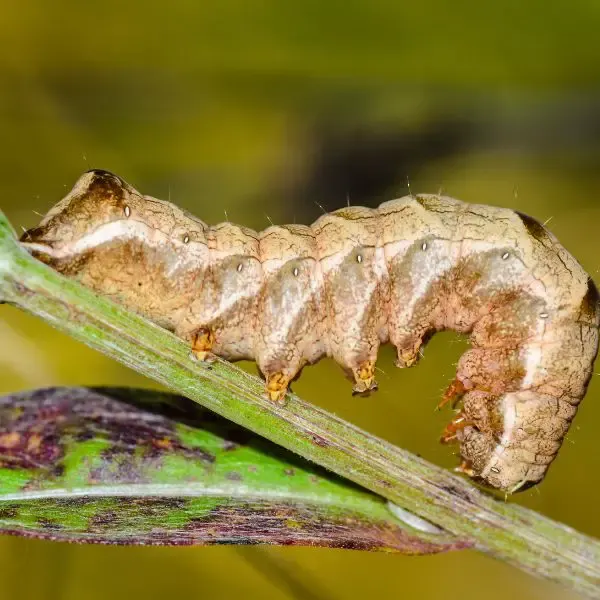
Despite the name, Cutworms aren’t actually worms, but larvae from certain types of night-flying moths. Like their adult selves, these pests prefer to sneak out at night, and they eat right through seedling stems at the soil level – yikes!
Sometimes these pests may be avoided by modifying a paper cup to place over the seedling, or some gardener’s will tape a makeshift ‘collar’ carefully in place that accomplishes the same thing – acting as a physical barrier to keep the cutworms from slicing your seedling stems until they can get a little bigger and start sprouting leaves!
Hornworms
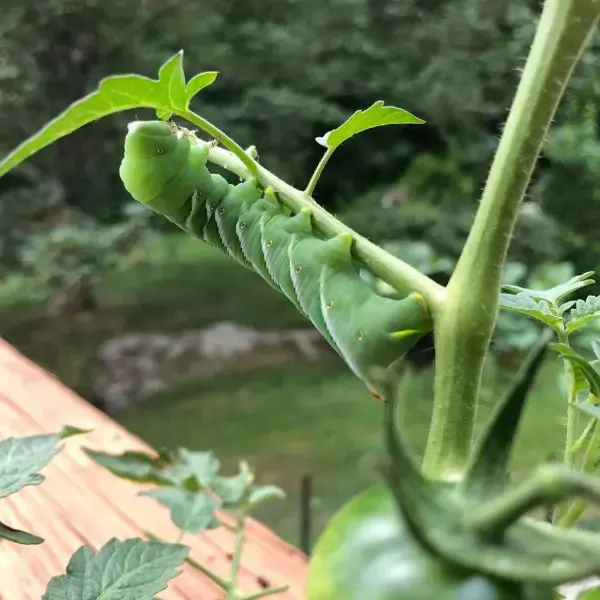
Unlike Cutworms, Hornworms are ACTUAL worms that grow to be about 2 to 3 inches long and with their bright green coloration, they’re almost perfectly camouflaged. These little worms will typically wait until night time, at which point they will systematically start eating leaves until they’ve exhausted a specific ‘section’ and then they’ll move on to the rest. Pesticides designed for caterpillars can usually make short work of Hornworms before they can do too much damage, and you can also plant pollinators nearby that will attract predatory wasps as a natural way to deal with these unwanted pests (don’t worry, we’ll elaborate on this later!)
Spider Mites

Spider mites are the smallest pests on our lists but their size doesn’t make them any less annoying or dangerous – they can do PLENTY of damage if you don’t deal with them. These little insects like to take bites of your tomato plant’s leaves and stems and you’ll notice very tiny holes or even areas that look as if they were ‘rusting’.
Neem oil sprays can help quite a bit with spider mites and helpful insects, such as ladybugs, love eating the little pests, so they are definitely manageable as long as you’re keeping an eye out for them!
Stink bugs

With a flattened, badge-shaped body, the Brown marmorated stink bug is a distinctive little insect and it’s definitely trouble for your tomatoes. Rather than settling for leaves, these guys and gals like to feed on the juice directly from ripening tomatoes. This will leave little, yellow spots on your tomatoes that look a lot like disease, but if you cut into one then you’ll see that it’s white underneath from having all the juice sucked out of that area!
Thankfully, they are vulnerable to insecticides, and you can also attract predators to eat them by planting certain pollinators that will attract their natural enemies.
Common tomato diseases
Insects aren’t the only worry when you are raising tomatoes, and in this section we’ll talk about some of the common health ailments they can contract through various diseases that these plants are susceptible to. We’ll focus on some of the most common, in this case:
- Anthracnose
- Early and Late Blight
- Mosaic Virus
- Septoria Leaf Spot
- Wilt (Fusarium and Verticillium)
We’ll expand on each of these so that you’ll know a little more about the symptoms and what to expect.
Anthracnose

Anthracnose is a fungus that is typically spread by splashed water when it’s warm and wet outside. You’ll recognize the telltale circular indent that appears in an affected tomato, which quickly develops rings as the fruit begins rotting away at the infected spot.
For avoiding this, picking your tomatoes quickly as they ripen is ideal, also you can help to avoid soil splashes with mulch and by avoiding overhead irrigation – the key is to try to keep the leaves and fruits from getting wet when avoidable.
Early and Late Blight
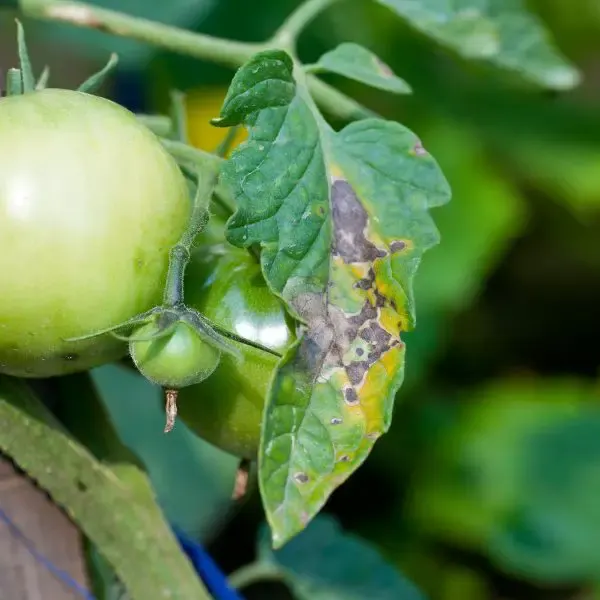
Early blight is a fungus that will show with black or brownish spots on your tomato plant’s leaves, typically with darker edges around those spots. Early blight starts before fruiting and is caused by the fungus Alternaria, but after fruiting another fungus called Phytophthora infestans can cause ‘Late blight’. While Alternaria fungus likes it wet and warm, Phytophthora comes into play when it’s cool and rainy.
This fungus will manifest as blackish-green splotches and it’s contagious if you’ve got potatoes nearby. In case of blight, typically you can trim the affected plants to remove the infected portions and fungicide is also quite useful at this point.
Mosaic Virus
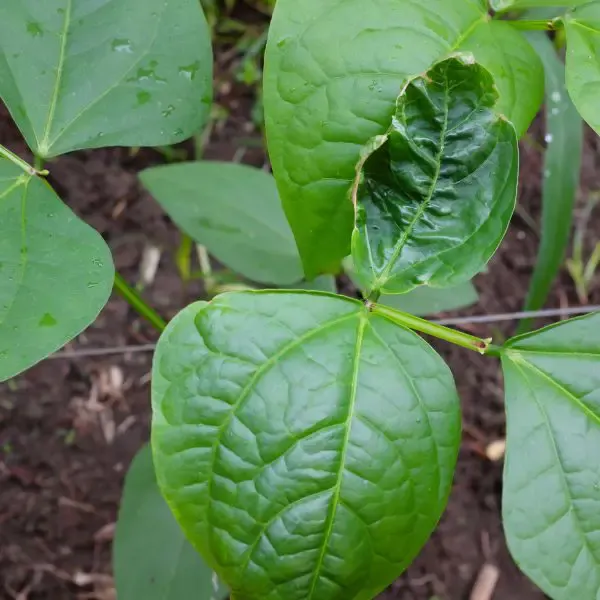
The Mosaic virus won’t kill your tomato plants, but it will greatly reduce the yield and the flavor of the fruits. The name itself comes from the appearance of the fruits when infected, as they look like a yellow and green mosaic. When this strikes, you’ll need to quickly remove and destroy the infected plants – just don’t stick them in your compost unless you want mosaic viruses hanging out there.
Also, a quick warning to smokers – clean your hands and don some garden gloves before handling your tomatoes, as the mosaic virus also affects tobacco plants and believe it or not, a quick smoke before handling your tomato plants might be all that is needed to infect them with the Mosaic virus!
Septoria Leaf Spot

Another fungal foe of tomato plants, Septoria leaf spot produces a grayish-white centered spot on tomato leaves that is dark-edged and sometimes comes with small black spots near the centers. Splashed water, as well as long periods of humidity can cause this to occur, so mulch can help for minimizing soil splashes and you should try to avoid overhead watering that can wet the leaves when it’s hot and humid.
Wilt (Fusarium and Verticillium)
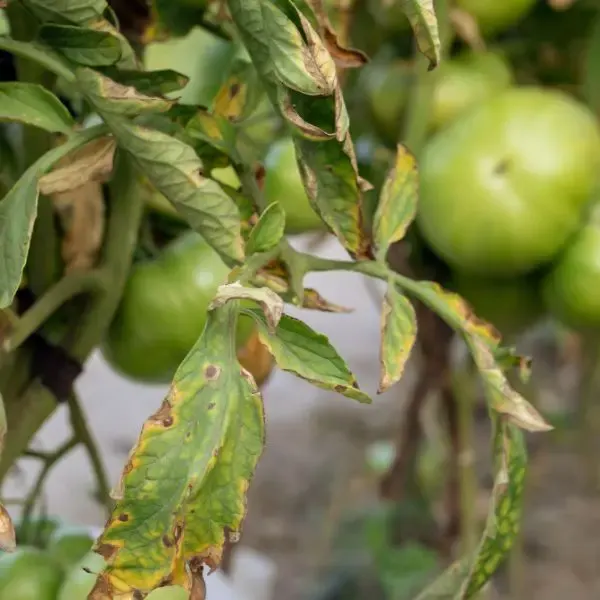
Fungi that is absorbed through the roots is responsible for Fusarium and Verticillium wilt and what happens is that the fungus will clog water-carrying vessels, so that it dehydrates the plant. When it starts, the top leaves of your tomatoes will be affected, and when it’s hot outside the plants will seem to weaken and wilt, although they straighten up a bit when the evening arrives and it’s cooler.
Unfortunately, as this is in the soil, when tomatoes get infected with wilt you cannot grow ore there (or any other nightshade plants), as the fungi will still be present in the soil for 4 to 6 years. There are, however, wilt-resistant tomatoes and investing in these from the get-go can help to reduce the chances of running into wilt in the first place (and we’ll have a section on disease resistance coming up shortly in this article so that you can easily identify these plants).
Other common causes of death for tomatoes
Beyond insects and disease, the most common cause of death for tomato plants is simply not being aware of their basic needs. Tomatoes do best in a loamy soil, enriched with humus, and a pH of 6.2 to 6.8 is ideal. Also, your typical garden-variety tomatoes need 1 to 2 inches of water a week.
Too much water will show with yellowing stems or leaves and sometimes you’ll see blistering on them, so you want to be very careful about the amounts and ALWAYS water at the base – getting the leaves or fruit wet is a recipe for fungus, so you’ll want to be very careful and mulch is a good idea.
Finally, during the growing season you want to fertilize every 4 to 6 weeks and with a bit of luck and your good care, you’ll have big, delicious tomatoes from your happy and healthy tomato plant.
What can I do to extend my tomato plant’s life?
Well, aside from growing it indoors where you’ll have less chance of disease and perfect climate control, the best strategies for longevity of a specific outdoor plant are choosing good companion plants, propagating clones, and understanding disease-resistance codes so that you can select hardy varieties of tomatoes.
We’ll talk about each of these so that you can add a few more strategies to your collection and put them to good use – let’s take a peek!
Companion plants can provide added security
Companion planting is fantastic stuff. The most famous example you’ll usually hear about is the ‘3 sisters’, which is a Native American tradition of growing pole beans, squash, and corn together. In this instance, they’re all perfectly suited for it – the beans produce nitrogen that helps the corn and squash grow, while the squash acts as a living mulch, and the beans use the corn as a trellis!
We’re going to go a little simpler here, however, by giving you some quick examples of companion plants and you can find 15 of them here if you’d like to learn more! That said, here are 3 good examples:
- Asparagus – Asparagus is a great companion option for tomatoes that can help to keep blight at bay by secreting a natural fungicide into the soil, and it also kills nearby root nematodes!
- Basil – Fresh basil is always nice to have in the kitchen, but growing in your garden with your tomatoes it’s also quite the useful herb. That’s because it can help to repel pests like hornworms, whiteflies, mosquitos, and more!
- Cilantro – Cilantro can make your salsa special and come in handy for a number of dishes, but an interesting fact about this herb is that Colorado Potato beetles really can’t stand the stuff. This makes for a great extra defense for your tomato plants!
You can always clone that beloved plant
The key to a tomato plant that is practically immortal is simply propagating cuttings from it so that you can essentially just keep growing clones! Around May to June, when your tomato plant has produced fruit, you’ll notice that it sprouts side shoots.
When you trim them, you can use the longer ones (3 to 7 inches) to grow clones of your plant. Just take the clipping, remove the lower leaves, and pop it into a glass of water. Keep that glass of water full and within 3 – 4 weeks’ time the cutting will develop a new root system and you can transfer it to a small pot to develop those roots a little more and voila – you’ve got a little clone of your tomato plant!
Understanding Resistance codes
When you are picking out the tomatoes you want to grow, you’ve probably noticed the capital letters listed on the package, and these pertain to disease resistance. Certain varieties of tomatoes will have special resistance perks bred right into them and choosing to grow these can save you a whole lot of headaches (and you might even find a new favorite tomato!). To make it simple, we’ve documented the resistance codes below in this little chart so that you can see what each one means.
| A | Alternaria alternata (early blight or stem canker) |
| F | Fusarium wilt |
| FF | Fusarium wilt types 1 and 2 |
| FFF | Fusarium wilt types 1, 2, and 3 |
| N | Nematodes |
| St | Stemphylium (aka Gray leaf spot) |
| T | Tobacco Mosaic virus |
| TSWV | Tomato spotted wilt virus |
| V | Verticillium wilt |
FAQs
We’re just about to wrap things up, but before we go we’ve got a few frequently asked questions on the subject of tomato plant longevity to share with you that we hope you’ll find useful. Let’s take a look!
Do tomato plants come back every year on their own?
Typically, no, or at least ‘not in most parts of the United States’. While tomatoes can thrive in tropical environments and produce fruits year-round in such conditions, our ‘local’ tomatoes have been relegated to being ‘annuals’.
That’s because they have to deal with the cold and accompanying frosts when winter arrives. Without any special protections from the chill, they usually don’t survive, although every now and again a ‘volunteer plant’ will show up as result of a dropped shoot from last year’s planting – it’s just very rare.
Do tomato plants produce more than one crop?
Determinate tomato plants will produce a single crop of fruit, while indeterminate varieties are capable of producing tomatoes until the frost slows them down or kills the plant. In areas where winters are mild, sometimes cloth fabric is placed to good effect over outside tomatoes to help with the chill.
Should I remove dead tomato plants?
Yes, if one of your tomato plants dies, it’s a good idea to remove it from the garden. While it seems like you could just leave it to decompose for a little extra fertilizer, this is not a good idea.
That’s because there might well be diseased leaves or pests that you can’t see (and their eggs) which might be waiting on the dead plant and could transfer to your healthy ones. So, remove the dead plant and keep it out of your compost pile for good measure.
Some final words
Today we’ve answered the question ‘how long does a tomato plant live?’ and while it’s typically 6 to 8 months, in tropical conditions they might live for YEARS. While we raise them as annuals, tomatoes are technically a short-lived perennial, but there are certainly ways of extending their life once you understand their needs.
Keep your plants from splashed water, for instance, to help minimize changes of certain fungal infections, and companion plants are also a good idea to help with pollination and beneficial insects that can help protect your plants.
Finally, don’t forget that you can propagate a new tomato plant from clipped shoots obtained during fruiting – it’s a neat little trick, really, and if you’re raising tomatoes indoors, then that’s about the closest thing to immortality that you can get for tomato plants!
Until next time, take good care of those tomatoes and we wish you the happiest of harvests!
More tomato guides
